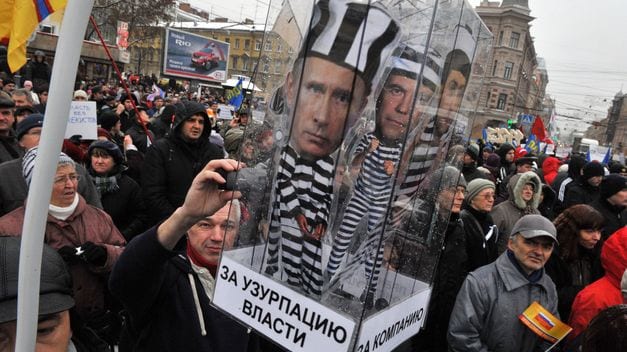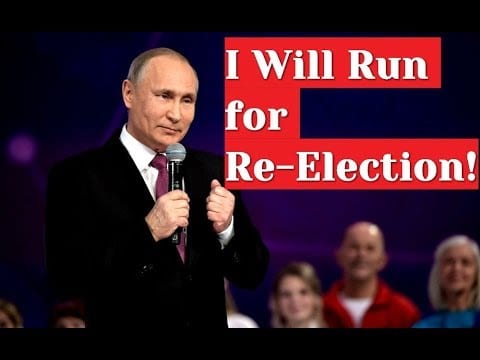Russia: between authoritarianism and active citizenship
In memory of Arseny Roginsky, a decent man
By Armando Chaguaceda

HAVANA TIMES — Five years ago, many Russians took to the streets to demand that the government respect their right to freely elect their authorities. Since then, social movements demanding different social, civil and political rights have figured in the news arriving from the Eurasian country.
In keeping with international public opinion’s renewed interest, Russia is a country whose national and foreign political agenda doesn’t do anything other than steal the limelight, in today’s world. This article comes in light of the above and in keeping with the series of pieces which we are publishing about public protests and repression worldwide in Havana Times (1).
Over the past quarter of a century, post-Soviet Russia has evolved from being a representative democracy to being a competitive authoritarian regime (2). While democratic institutions continue to formally exist, these are manipulated to the core by the government in a systematic manner against the opposition. This doesn’t mean nullifying opposition parties, but rather fencing them in (with local government victories and one-off provincial government positions) and, more particularly, channelizing them outside of established institutions with uprisings and protests.
Therefore, what we see in competitive authoritarian regimes such as the one in Russia is that political party opportunities for action can be found somewhere in the middle of the spectrum: greater repect for more open systems of government (liberal democracies such as the US or Chile), where the need to invade public spaces is relatively low and there are alternative channels for a political debate; but also respect for other more closed governments (single-party autocracies such as China and Cuba), where any efforts to mobilize can be successfully repressed.
The Russian experience has shown how the reaction to people’s protests by this kind of government can vary and has specific dynamics: as a starting point, it can be characterized by the implementation of a series of concessions so as to ease tensions; but after this initial phase, repression is used to try and quell sources of political uncertainty.
When the authorities crack down...
During the first decade of the 21st Century, at the same time the country was financially recovering (linked to high oil prices on the global market and arms exports), the rejig of the Russian State (which meant greater bureaucracy, recentralizing political and administrative powers) and the growth of the middle class (linked to the boom in urban consumerism) also led to different forms of protest against government policies.
In 2004, thousands of Russians marched in protest against the new Moscow-St. Petersburg highway and in 2006, citizens took to the streets to protest against price hikes. Although these abovementioned protests had two peculiarities: not enough coordination on a national level and people were calling upon the authorities to fix these problems.
As a result, these direct and one-off protests slowly became various marches, assemblies and meetings. The strategic use of technology (the Internet, cellphones, social media) became extremely important in this mass mobilization movement, as well as Moscow’s role as the main stage for mass protest organization.
At the end of the 21st century’s first decade, the frustration of important sectors in society (especially groups within the urban middle class) toward the official establishment grew considerably as a result of several factors: corruption scandals, the absence of systematic reforms and rumors (which were later confirmed) of Putin’s new candidacy for president.
While the population was hopeful in 2009 about President Medvedev’s reformist politics, a constitutional amendment was approved in 2011 which extended the presidency from 4 years to 6 years. Russian democrats then understood that Medvedev had been “used” by Putin to hold a third term in office and that the latter’s intention was to stay in power for a very long time.
Russia’s authoritarian government began to lose legitimacy in the eyes of its more educated, politically active and mobilized population; stirring feelings of dissatisfaction with the status quo among them.
This is how the wave of protests known as “the Snow Revolution” (because of the white ribbons partcipants’ wore) began, which went on until March 2012, in which many mass protests were held across the whole of Russia (3). Civil discontent began to be focused on the State as a whole and not on individuals and individual government institutions like it had been in the past.
… protests break out
The 2011-2012 Russian protests weren’t the result of civil society’s awakening, but rather the result of a process of changes in Russian society that had been ongoing during the previous decade, at the same time as Putin’s first term in power. Suspicions of electoral fraud in 2011 and the Russian people’s consequent frustration and loss of hope all served as firewood for the mass mobilization movement.
Beyond its importance and the practical results it achieved, the Snow Revolution was probably a symptom of a series of social changes that were taking place in the country, of a wide range of concessions and, more generally, of the need to establish a dialogue between institutions of power and the public.
Since then, a particular focus on new forms of public and opposition protests, which have displayed the limits of Putin’s regime and have affected the perception of the Russian state as a competent system of government, has come to light.
On the other hand, the government’s ongoing crackdown has affected the willingness of a large group of Russian citizens to take part in protests held to demand rights (especially civic and political rights) and better living conditions. A significant number of them support the establishment of a political system that moves away from both Western democracy and the Soviet government, revealing the government’s partial success with its propaganda directed at the need to adopt the “competitive authoritarian regime” model which is labeled “sovereign democracy”.

As recent studies by the Levada-Center highlight, the role of government-controlled media (and propaganda), the weight of nationalist, paternalist and statist traditions in Russia’s political culture as well as the material and cultural backwardness of many sectors of its population (which are linked to the middle class’ conservative aspirations and ties with State bureacracy) constitute a kind of attitude which doesn’t lean towards active political participation and support for structural reforms within Russia’s current system.
However, changes in another of the population’s politically active sectors (youth groups, the middle class and urban working class, intellectual democrats and left-wing activists, among others) don’t seem to disappear, even when you take the limits of existing institutions into account.
Social movements produce deep transformations in political cultures, in perceptions and in the people involved; some of these are built up, buried and then rise up when the time is right. Therefore, echoes of the 2011-2012 protests can be seen today, in another context and in a different way.
The surprising anti-corruption protests that took place in March 2017, led by young people from different social classes in many of the country’s cities, as well opposition rallies at the end of the year (led by A. Navalny) are proof of this.
According to political expert Andrei Kolesnikov, Chair of the Russian Domestic Politics and Political Institutions Program at the Carnegie Moscow Center, there are links between the 2011-2012 events and the protests this year in that “the main characteristic of those protests (such as the one that took place on March 26th) were more motivated by ethics than politics. They weren’t directed at taking power: they were denouncing the authorities’ dishonesty.”
Protests last spring across the whole of Russia further reveal an active society, who call out the authorities, with more “socio-economic” motivations – corruption and their impact on society – than “civil/political” motivations.
If protests in 2011-2012 were neutralized by a combination of repressive acts, propaganda and concessions, the existence of scattered protests and demands closely linked to local grievances have made them difficult to criminalize. And they can be useful for leaders from the harshly criticized opposition to reconnect with the people and to unite forces with the wave of discontent that is the result of the upcoming 2018 elections.
For a Kremlin used to high levels of popular consensus and social support (the results of post-Crimea patriotism and the country’s dispute with the West), mass mobilization across the social strata in large metropoli and cities in the country’s interior, could be a sign that its feedback channels with the population need to be revised (4).
Today’s situation could be settled with a strategy that pays attentions to civil complaints (the fight against corruption, better social politics, dialogue with civil society) or on the contrary, with an escape forwards, with greater social control and reinforcing the military and state security’s presence in public spaces as well as Putin’s political priorities.
As political analyst Tatiana Stanovaya, director of the analytical department of the Center of Political Technologies in Moscow, the situation of the president relaunching another candidature for another term in office (from 2018 to 2024) is a moment of great political sensitivity. So, regardless of what measures the Russian government takes, it seems that the Kremlin won’t be able to confide in its citizens being completely satisfied in upcoming years. In spite of everything, politics are still alive and kicking in Russia.
———
Notes:
1- This article summarizes some of the results of a more in-depth study of politics and public protests in Russia, which was carried out in collaboration with my colleague James D’Angelo, and will soon be published. I am grateful for the opinions Andrei Kolesnikov, Tatiana Stanovaya and Alexey Kovalev shared. For further reading about the subject, I recommend articles by A. Baunov, A. Kolesnikov, A. Cheskin, T. Lankina, S. Greene and D. White, which appear in magazines such as Communist and Post-Communist Studies, Post-Soviet Affairs, Communist Studies and Transition Politics, Communisme and Demokratizatsiya: The Journal of Post-Soviet Democratization, as well as books by Samuel A Greene “Moscow in Movement: Power and Opposition in Putin´s Russia” (Stanford University Press, 2014) y de G.B Robertson “The Politics of Protest in Hybrid Regimes: Managing Dissent in Post-Communist Russia” (Cambridge University Press, 2010).
2- Representative democracy according to Guillermo O’Donnell’s definition; competitive authoritarian regime in line with Steve Levitsky and Lucan Way’s definition.
3- Some sources say that this wave of protests lasted until 2013, but the main events took place in 2011 and 2012, as a result of the legislative and presidential elections. For a good summary about these events (with links to biographies, video testimonies and press articles), read https://en.wikipedia.org/wiki/2011%E2%80%9313_Russian_protests
4- As journalist A. Kovalev, an expert in Russian politics and writer for the Moscow Times, OpenDemocracy and The Guardian, points out to the author: “a state media blackout failed because there are now independent outlets and blogs rushing to fill the void. So the unforeseen consequences are a difficult media reform (state media concentrate on foreign coverage while ignoring domestic matters), maybe less pressure on civil society groups because it’s just making things worse, maybe some token compromises, because there’s a presidential election coming up in 2018 and you can’t just tighten the screws forever.”





